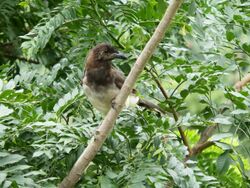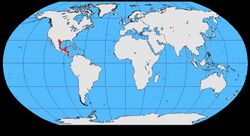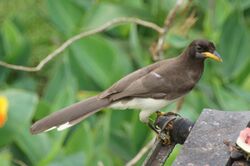Biology:Brown jay
| Brown jay | |
|---|---|

| |
| Adult bird. Aserrí, Costa Rica | |
| Scientific classification | |
| Domain: | Eukaryota |
| Kingdom: | Animalia |
| Phylum: | Chordata |
| Class: | Aves |
| Order: | Passeriformes |
| Family: | Corvidae |
| Genus: | Psilorhinus Rüppell, 1837 |
| Species: | P. morio
|
| Binomial name | |
| Psilorhinus morio (Wagler, 1829)
| |

| |
| Range (click to magnify) | |
| Synonyms | |
|
Cyanocorax morio | |
The brown jay (Psilorhinus morio) is a large jay native to North and Central America.
Description
Brown jays vary in plumage geographically: there are two main groups. Northern birds are almost completely dark brown, with lighter brown on the underparts. Southern birds are white-bellied and have bright white tips to the outer tail feathers. The intergrade zone is in Veracruz, Mexico.
Adults in both populations have black bills, legs, and feet. Immatures have yellow bare parts, including yellow eye-rings.
The voice is a loud but low-pitched pee-ah call and is often modified to suit its situation or mood.
Ecology
Food is sought largely in trees but brown jays also take some food from the ground. They are rather indiscriminate feeders. Insects and a wide range of other invertebrates are taken, also lizards, nectar, and fruit (e.g. that of Trophis racemosa in the Moraceae).[2] Though they will take eggs and nestlings, they appear not to if there is plenty of other food available.
The nest is built in a tree or large shrub with both sexes helping in construction. There are normally three eggs laid but six is not unusual. Incubation is between 18 and 20 days. Only the female broods but the male feeds her while doing so.
Sometimes the offspring from a previous season will help in raising the chicks. If a helper bird returns with food, it will give it to one of the resident parents to feed the chicks.
Range
It occurs from Mexico south into Central America on the Gulf slope. The northernmost extent of the bird is in the Rio Grande Valley of Texas . In Central America, the brown jay is not found in El Salvador.
References
- ↑ BirdLife International (2020). "Cyanocorax morio". IUCN Red List of Threatened Species 2020: e.T22705742A137751528. doi:10.2305/IUCN.UK.2020-3.RLTS.T22705742A137751528.en. https://www.iucnredlist.org/species/22705742/137751528. Retrieved 1 October 2022.
- ↑ Foster, Mercedes S. (2007). "The potential of fruiting trees to enhance converted habitats for migrating birds in southern Mexico". Bird Conservation International (BirdLife International) 17 (1): 45–61. doi:10.1017/S0959270906000554.
Further reading
- Skutch, Alexander F. (1960). "White-tipped brown jay". Life Histories of Central American Birds II. Pacific Coast Avifauna, Number 34. Berkeley, California: Cooper Ornithological Society. pp. 231–257. https://sora.unm.edu/sites/default/files/journals/pca/pca_034.pdf#page=232.
External links
- "Brown jay media". Internet Bird Collection. http://www.hbw.com/ibc/species/brown-jay-psilorhinus-morio.
- Brown jay photo gallery at VIREO (Drexel University)
Wikidata ☰ {{{from}}} entry
 |



